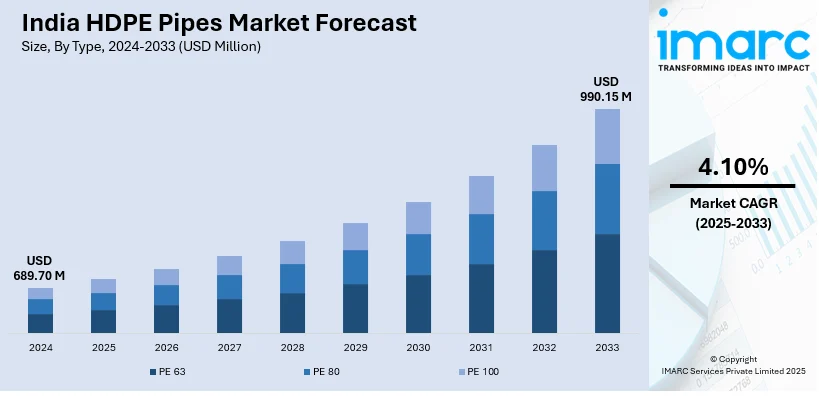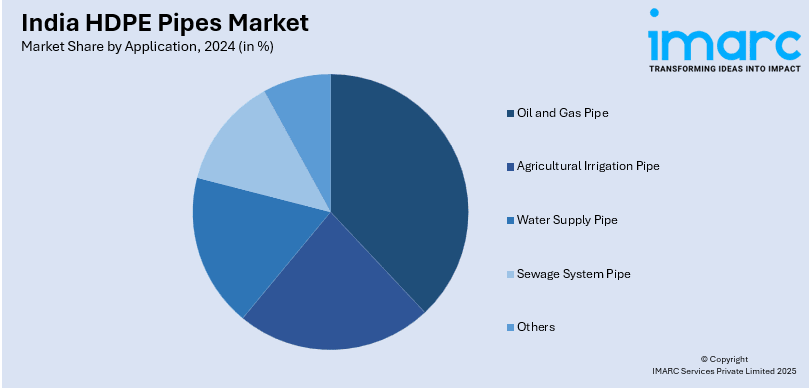
India HDPE Pipes Market Size, Share, Trends, and Forecast by Type, Application, and Region, 2025-2033
India HDPE Pipes Market Size and Share:
The India HDPE pipes market size reached USD 689.70 Million in 2024. Looking forward, IMARC Group expects the market to reach USD 990.15 Million by 2033, exhibiting a growth rate (CAGR) of 4.10% during 2025-2033. The market is witnessing continual growth with infrastructure development, agricultural irrigation, and industrial applications driving growth. In addition, government programs, like PMKSY, are helping facilitate the demand while technology is improving pipe performance.
|
Report Attribute
|
Key Statistics
|
|---|---|
|
Base Year
|
2024
|
|
Forecast Years
|
2025-2033
|
|
Historical Years
|
2019-2024
|
| Market Size in 2024 | USD 689.70 Million |
| Market Forecast in 2033 | USD 990.15 Million |
| Market Growth Rate (2025-2033) | 4.10% |
India HDPE Pipes Market Trends:
Increasing Demand for HDPE Pipes in Infrastructure Development
The Indian market for HDPE pipes is increasing substantially with the fast-paced infrastructure growth of the country. Government programs like the Smart Cities Mission, Atal Mission for Rejuvenation and Urban Transformation (AMRUT), and Pradhan Mantri Krishi Sinchayee Yojana (PMKSY) are fueling investments in water and sewage infrastructure, which subsequently increases the demand for corrosion-resistant and long-lasting HDPE pipes. For instance, in January 2024, the Government of India (GOI) announced plans to launch sewage projects in Mathura and Moradabad, Uttar Pradesh, which include the construction of sewage treatment plants, network expansion, and pollution control measures, with a total investment of Rs 7.9 Billion. Additionally, these pipes are widely used for water supply distribution, sewerage networks, irrigation systems, and industrial processes due to their chemical resistance, high pressure ability, and weather resistance. Urbanization and population increase in India are also exerting pressure on the available infrastructure, necessitating efficient and more durable piping solutions. Similarly, as urban areas grow and new rural infrastructure developments are initiated, the demand for HDPE pipes will keep growing, further fueling market expansion. Furthermore, the ease of installation, flexibility, and cost-effectiveness of HDPE pipes make them a choice for both government and private sector infrastructure projects.

Growth in Agriculture and Irrigation Applications
The agriculture sector in India is a major contributor to the increasing demand for HDPE pipes, particularly in irrigation systems. With the country’s agriculture largely dependent on monsoon rainfall, the need for efficient water management systems has become critical. For instance, as per industry reports, the Indian agriculture sector's share of GVA was 17.7% in FY24, with growth slowing due to erratic weather and uneven monsoon distribution, thereby facilitating the demand for HDPE pipes. HDPE pipes offer superior benefits for irrigation, including high durability, resistance to chemical corrosion, and low maintenance, making them ideal for delivering water across large agricultural areas. However, these pipes help ensure water reaches crops efficiently, reducing wastage and improving yield. Furthermore, the rising focus on sustainable agriculture and water conservation is driving the adoption of HDPE pipes for drip and sprinkler irrigation systems, helping farmers reduce water usage while improving productivity. As the agricultural sector modernizes, demand for HDPE pipes in irrigation and water management will continue to rise, supporting overall market growth.
India HDPE Pipes Market Segmentation:
IMARC Group provides an analysis of the key trends in each segment of the market, along with forecasts at the region level for 2025-2033. Our report has categorized the market based on type and application.
Type Insights:
- PE 63
- PE 80
- PE 100
The report has provided a detailed breakup and analysis of the market based on the type. This includes PE 63, PE 80, and PE 100.
Application Insights:

- Oil and Gas Pipe
- Agricultural Irrigation Pipe
- Water Supply Pipe
- Sewage System Pipe
- Others
A detailed breakup and analysis of the market based on the application have also been provided in the report. This includes oil and gas pipe, agricultural irrigation pipe, water supply pipe, sewage system pipe, and others.
Regional Insights:
- North India
- South India
- East India
- West India
The report has also provided a comprehensive analysis of all the major regional markets, which include North India, South India, East India, and West India.
Competitive Landscape:
The market research report has also provided a comprehensive analysis of the competitive landscape. Competitive analysis such as market structure, key player positioning, top winning strategies, competitive dashboard, and company evaluation quadrant has been covered in the report. Also, detailed profiles of all major companies have been provided.
India HDPE Pipes Market News:
- In October 2023, Raksha Pipes announced plans to expand its capacity tenfold by FY29 in oredr to target a Rs 3,000 Crore turnover. The company aims to strengthen its position in the HDPE pipes and agri-pipe market.
India HDPE Pipes Market Report Coverage:
| Report Features | Details |
|---|---|
| Base Year of the Analysis | 2024 |
| Historical Period | 2019-2024 |
| Forecast Period | 2025-2033 |
| Units | Million USD |
| Scope of the Report |
Exploration of Historical Trends and Market Outlook, Industry Catalysts and Challenges, Segment-Wise Historical and Future Market Assessment:
|
| Types Covered | PE 63, PE 80, PE 100 |
| Applications Covered | Oil and Gas Pipe, Agricultural Irrigation Pipe, Water Supply Pipe, Sewage System Pipe, Others |
| Regions Covered | North India, South India, East India, West India |
| Customization Scope | 10% Free Customization |
| Post-Sale Analyst Support | 10-12 Weeks |
| Delivery Format | PDF and Excel through Email (We can also provide the editable version of the report in PPT/Word format on special request) |
Key Questions Answered in This Report:
- How has the India HDPE pipes market performed so far and how will it perform in the coming years?
- What is the breakup of the India HDPE pipes market on the basis of type?
- What is the breakup of the India HDPE pipes market on the basis of application?
- What is the breakup of the India HDPE pipes market on the basis of region?
- What are the various stages in the value chain of the India HDPE pipes market?
- What are the key driving factors and challenges in the India HDPE pipes market?
- What is the structure of the India HDPE pipes market and who are the key players?
- What is the degree of competition in the India HDPE pipes market?
Key Benefits for Stakeholders:
- IMARC’s industry report offers a comprehensive quantitative analysis of various market segments, historical and current market trends, market forecasts, and dynamics of the India HDPE pipes market from 2019-2033.
- The research report provides the latest information on the market drivers, challenges, and opportunities in the India HDPE pipes market.
- Porter's five forces analysis assist stakeholders in assessing the impact of new entrants, competitive rivalry, supplier power, buyer power, and the threat of substitution. It helps stakeholders to analyze the level of competition within the India HDPE pipes industry and its attractiveness.
- Competitive landscape allows stakeholders to understand their competitive environment and provides an insight into the current positions of key players in the market.
Need more help?
- Speak to our experienced analysts for insights on the current market scenarios.
- Include additional segments and countries to customize the report as per your requirement.
- Gain an unparalleled competitive advantage in your domain by understanding how to utilize the report and positively impacting your operations and revenue.
- For further assistance, please connect with our analysts.
 Inquire Before Buying
Inquire Before Buying
 Speak to an Analyst
Speak to an Analyst
 Request Brochure
Request Brochure
 Request Customization
Request Customization




.webp)




.webp)












